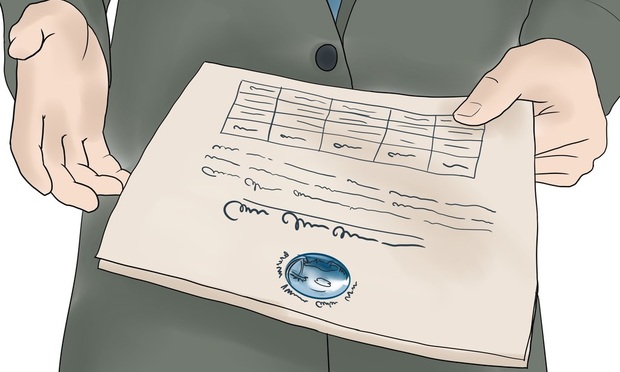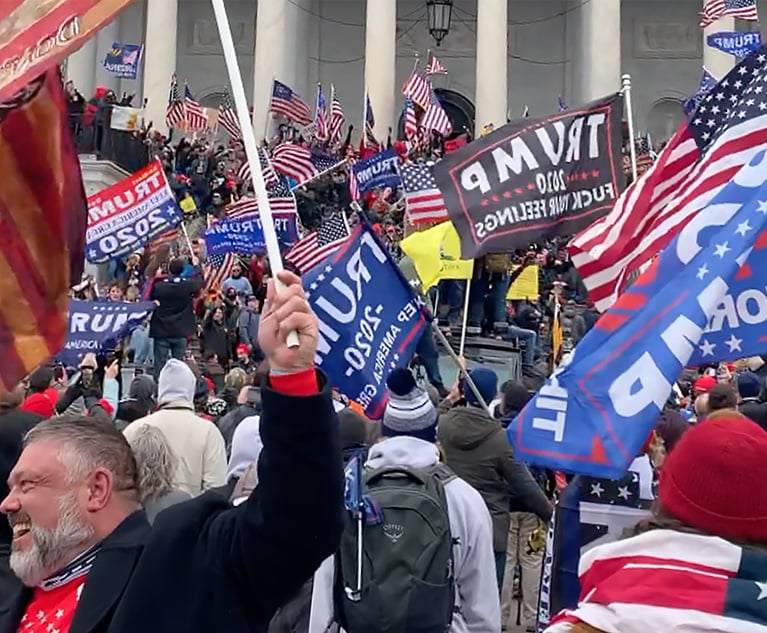Interim Comment on Use of Remote Notarizations, Pursuant to Executive Order 202.7
Specific procedures must be followed to remotely notarize a document and to help the public and notaries public understand the Executive Order, the New York State Department of Licensing has posted clear guidelines.
April 28, 2020 at 11:00 AM
5 minute read
 On March 19, 2020, Gov. Andrew Cuomo signed Executive Order 202.7, which authorizes notaries public to officiate documents remotely. Because of that measure, transactions have been able to move forward as people are warming up to this new procedure. There has been some resistance to using the e-notary option now available because of concerns of authentication and chain of custody of the documents going back and forth electronically. This comment is submitted to assist in alleviating those concerns by illustrating the procedure and by recommending a certification form to use for purposes of mapping out and memorializing the new procedure.
On March 19, 2020, Gov. Andrew Cuomo signed Executive Order 202.7, which authorizes notaries public to officiate documents remotely. Because of that measure, transactions have been able to move forward as people are warming up to this new procedure. There has been some resistance to using the e-notary option now available because of concerns of authentication and chain of custody of the documents going back and forth electronically. This comment is submitted to assist in alleviating those concerns by illustrating the procedure and by recommending a certification form to use for purposes of mapping out and memorializing the new procedure.
Specific procedures must be followed to remotely notarize a document and to help the public and notaries public understand the Executive Order, the New York State Department of Licensing has posted clear guidelines on its website (last accessed April 21, 2020).
According to the executive order, the notary and the person seeking services must have direct interaction, with no pre-recorded videos of the person signing; the person must prove that they are physically in the state of New York; the person must send a legible copy of the signed document to the notary electronically on the date it's signed, with the notary sending a copy of the document back; and the notary will later re-notarize the original signed document after receiving it, along with the electronically notarized copy, within 30 days.
E-Notary Illustrated
STEP ONE: You set up a video conference allowing for direct, live interaction between the notary and the person signing the document—WhatsApp, FaceTime, Google Hangouts, Zoom, Skype, e.g.
NOTARY: Can you see me okay?
Person Signing: Huh? Yeah … hey!
STEP TWO: That person must then present to the camera, so the Notary can see, a valid photo ID.
NOTARY: Can you please put your photo ID up to the camera?
Person: Driver's license good?
NOTARY: Yes. Face the photo-side toward the camera. Closer … cloooooser! Okay hold it there. And you are Marc Bolan?
Person: Yeah.
STEP THREE: The person signing must affirmatively say to the notary that they are in the state of New York.
NOTARY: And are you present in the State of New York right now?
Person: Yeah. Queens.
STEP FOUR: The person signing must then sign the document and send the signed document by email or fax on the same day that it was signed.
NOTARY: Great! Please sign the document. There ya go. Excellent. Okay, please e-mail me or fax the document to my number, okay?
Person: Can I do it tomorrow?
NOTARY: NO!!! Today.
STEP FIVE: The notary then notarizes the copy of the document they receive and sends it back to the person who signed it.
STEP SIX: The notary will later re-notarize the original signed document after receiving it, along with the electronically notarized copy. But that must be done within 30 days of the electronic notarization.
STEP SEVEN: The notary then creates and executes an e-notary certification.
This is a form that I submit to my brother and sister notaries to consider using:
E-Notary Certification
[Notarization Made Pursuant To Executive Order 202.7]
______________________, a notary public duly commissioned by the New York State Secretary of State's office, states the following under penalties for perjury:
- On ____________________, 2020, I witnessed the annexed document(s) being signed, using audiovideo technology, and then notarized same by placing my seal and signature thereon.
- The person seeking the Notary's services, was not personally known to me and, therefore, upon request, presented a valid photo ID to me during the video conference held this day via __________________.
- The video conference allowed for direct interaction between the person signing and me.
- The person signing affirmatively represented that they were physically situated in the State of New York, County of ________________, Your affirmant was located at _________________________, the time of this electronic notarization.
- I then witnessed the person execute the document(s). The person then transmitted, via electronic means a legible copy of the signed document(s) directly to my email address (____________________) on the same date it was signed.
- I then notarized the transmitted copy of the document(s) and transmitted the same back to the person on the same day.
- The notarization of the original signed document will be completed within thirty days after the date of execution, which said original will be dated this day, _____________, 2020, and kept together with the electronically notarized copy.
Dated: __________, New York ______________, 2020
NOTARY: ________________________
Commission Expires: _________________
Executive Order 202.7, is a valuable tool that facilitates legal and transactional work while maintaining proper public health protocols currently in place.
Joseph D. Nohavicka is a partner at Pardalis & Nohavicka.
This content has been archived. It is available through our partners, LexisNexis® and Bloomberg Law.
To view this content, please continue to their sites.
Not a Lexis Subscriber?
Subscribe Now
Not a Bloomberg Law Subscriber?
Subscribe Now
NOT FOR REPRINT
© 2025 ALM Global, LLC, All Rights Reserved. Request academic re-use from www.copyright.com. All other uses, submit a request to [email protected]. For more information visit Asset & Logo Licensing.
You Might Like
View All
‘Catholic Charities v. Wisconsin Labor and Industry Review Commission’: Another Consequence of 'Hobby Lobby'?
8 minute read
AI and Social Media Fakes: Are You Protecting Your Brand?

Neighboring States Have Either Passed or Proposed Climate Superfund Laws—Is Pennsylvania Next?
7 minute readTrending Stories
- 1LexisNexis Announces Public Availability of Personalized AI Assistant Protégé
- 2Some Thoughts on What It Takes to Connect With Millennial Jurors
- 3Artificial Wisdom or Automated Folly? Practical Considerations for Arbitration Practitioners to Address the AI Conundrum
- 4The New Global M&A Kings All Have Something in Common
- 5Big Law Aims to Make DEI Less Divisive in Trump's Second Term
Who Got The Work
J. Brugh Lower of Gibbons has entered an appearance for industrial equipment supplier Devco Corporation in a pending trademark infringement lawsuit. The suit, accusing the defendant of selling knock-off Graco products, was filed Dec. 18 in New Jersey District Court by Rivkin Radler on behalf of Graco Inc. and Graco Minnesota. The case, assigned to U.S. District Judge Zahid N. Quraishi, is 3:24-cv-11294, Graco Inc. et al v. Devco Corporation.
Who Got The Work
Rebecca Maller-Stein and Kent A. Yalowitz of Arnold & Porter Kaye Scholer have entered their appearances for Hanaco Venture Capital and its executives, Lior Prosor and David Frankel, in a pending securities lawsuit. The action, filed on Dec. 24 in New York Southern District Court by Zell, Aron & Co. on behalf of Goldeneye Advisors, accuses the defendants of negligently and fraudulently managing the plaintiff's $1 million investment. The case, assigned to U.S. District Judge Vernon S. Broderick, is 1:24-cv-09918, Goldeneye Advisors, LLC v. Hanaco Venture Capital, Ltd. et al.
Who Got The Work
Attorneys from A&O Shearman has stepped in as defense counsel for Toronto-Dominion Bank and other defendants in a pending securities class action. The suit, filed Dec. 11 in New York Southern District Court by Bleichmar Fonti & Auld, accuses the defendants of concealing the bank's 'pervasive' deficiencies in regards to its compliance with the Bank Secrecy Act and the quality of its anti-money laundering controls. The case, assigned to U.S. District Judge Arun Subramanian, is 1:24-cv-09445, Gonzalez v. The Toronto-Dominion Bank et al.
Who Got The Work
Crown Castle International, a Pennsylvania company providing shared communications infrastructure, has turned to Luke D. Wolf of Gordon Rees Scully Mansukhani to fend off a pending breach-of-contract lawsuit. The court action, filed Nov. 25 in Michigan Eastern District Court by Hooper Hathaway PC on behalf of The Town Residences LLC, accuses Crown Castle of failing to transfer approximately $30,000 in utility payments from T-Mobile in breach of a roof-top lease and assignment agreement. The case, assigned to U.S. District Judge Susan K. Declercq, is 2:24-cv-13131, The Town Residences LLC v. T-Mobile US, Inc. et al.
Who Got The Work
Wilfred P. Coronato and Daniel M. Schwartz of McCarter & English have stepped in as defense counsel to Electrolux Home Products Inc. in a pending product liability lawsuit. The court action, filed Nov. 26 in New York Eastern District Court by Poulos Lopiccolo PC and Nagel Rice LLP on behalf of David Stern, alleges that the defendant's refrigerators’ drawers and shelving repeatedly break and fall apart within months after purchase. The case, assigned to U.S. District Judge Joan M. Azrack, is 2:24-cv-08204, Stern v. Electrolux Home Products, Inc.
Featured Firms
Law Offices of Gary Martin Hays & Associates, P.C.
(470) 294-1674
Law Offices of Mark E. Salomone
(857) 444-6468
Smith & Hassler
(713) 739-1250







